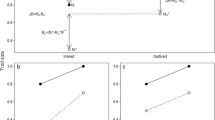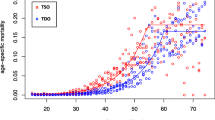Summary
An initially rare allele with a large effect on a quantitative character is expected to exhibit the following behaviour in artificial selection lines:
-
1.
It should change in frequency, or be lost by chance, at rates predictable from the effects of the allele on the quantitative character and the selection regime imposed.
-
2.
At the phenotypic level the behaviour of the allele should cause (a) asymmetrical responses to bidirectional selection, (b) variation among replicate lines in response to selection corresponding to the behaviour of the allele in individual lines, (c) changes in heritability in lines in which the allele increases in frequency and (d) selection response compatible with the effects of the allele.
This paper reports an experimental evaluation of these predictions utilizing a rare allele of large effect (sm lab) detected in a sample of the Canberra outbred population of Drosophila melanogaster at a frequency of 1/120. Homosygosity for this allele reduced abdominal bristle number by more than 50%, altered the abdominal bristle pattern and reversed the sexual dimorphism for abdominal bristle number. Experiments were done to characterise sm lab and all evidence indicates that it is a single allele with a very large effect.
Bidirectional selection for abdominal bristle number was carried out in three high and three low lines from this sample of the Canberra population. The sm lab allele rose in frequency and went to fixation in two of the low lines (in 10 generations) but was lost from the third. These times to fixation were slower than the expectations derived from computer simulations of the behaviour of such an allele but this can be attributed to the lower fitness of sm lab homozygotes. The proportions of lines with the allele fixed or lost were compatible with expectations. At the phenotypic level, the behavior of sm lab had the expected consequences, namely, (i) asymmetrical responses to bidirectional selection, (ii) variation in response among replicate low lines corresponding to the behaviour of sm lab, (iii) changes in heritabilities in the lines in which sm lab went to fixation, and (iv) selection responses compatible with the effects of the allele.
A test for rare alleles of large effect was proposed, based on the expected pattern of change in heritability under artificial selection. This test was applied to the high selection lines but no evidence was found for important effects due to rare alleles of large effect increasing abdominal bristle number, a conclusion consistent with other independent evidence.
This work provides experimental corroboration of the links between population genetics and quantitative genetics.
Similar content being viewed by others
Literature
Avery, P.J.; Hill, W.G. (1977): Variability in genetic parameters among small populations. Genet. Res. 29, 193–213
Beardmore, J.A.; Lints, F.; Al-Baldawi, A.T.F. (1975): Parental age and heritability of sternopleural chaeta number in Drosophila melanogaster. Heredity 34, 71–82
Beardmore, J.A.; Shami, S.A. 1976: Parental age, genetic variation and selection. In: Population genetics and ecology (eds.: Karlin, S.; Nevo, E.), pp. 3–22. London: Acad. Press
Bulmer, M.G. (1976): The effect of selection on genetic variability: A simulation study. Genet. Res. 28, 101–117
Claxton, J.H. (1974): Some quantitative features of Drosophila sternite bristle patterns. Austr. J. Biol. Sci. 27, 533–543
Constantino, R.F.; Bell, A.E.; Rogler, J.C. (1967): Genetic analysis of a population of Tribolium. 1: Corn oil sensitivity and selection response. Heredity 22, 529–539
Crow, J.F.; Kimura, M. 1970: An Introduction to Population Genetics Theory. New York: Harper and Row
Durrant, A. (1974): The association of induced changes in flax. Heredity 32, 133–143
East, E.M. (1916): Studies on size inheritance in Nicotiana. Genetics 1, 164–176
Falconer, D.S. (1960): Introduction to Quantitative Genetics. Edinburgh: Oliver and Boyd
Falconer, D.S. (1977): Some results of the Edinburgh selection experiments with mice. In: Proc. Int. Conf. Quant. Genetics (Eds.: Pollak, E.; Kempthorne, O.; Bailey, T.B.Jr.), pp. 101–115. Ames: Iowa State Univ.
Felsenstein, J. (1965): The effect of linkage on directional selection. Genetics 52, 349–363
Fisher, R.A. (1918): The correlation between relatives on the supposition of Mendelian inheritance. Trans. Roy. Soc. Edinburgh 52, 399–433
Fisher, R.A. 1930: The Genetical Theory of Natural Selection. Oxford: Clarendon
Fowler, R.E.; Edwards, R.G. (1961): ‘Midget’, a new dwarfing gene in the house mouse dependent on a genetic background of small body size for its expression. Genet. Res. 2, 272–282
Frankham, R. (1974): The nature of quantitative genetic variation in Drosophila. 2: Average dominance of abdominal bristle polygenes. Austr. J. Biol. Sci. 27, 683–686
Frankham, R. (1977): The nature of quantitative genetic variation in Drosophila. 3: Mechanism of dosage compensation for sex-linked abdominal bristle polygenes. Genetics 85, 185–191
Frankham, R. (1980): The founder effect and response to artificial selection in Drosophila. In: Proc. Int. Sym. on Selection Experiments on Laboratory and Domestic Animals (ed.: Robertson, A.)
Frankham, R.; Briscoe, D.A.; Nurthen, R.K. (1978): Unequal crossing over at the rRNA locus as a source of quantitative genetic variation. Nature 272, 80–81
Frankham, R.; Briscoe, D.A.; Nurthen, R.K. (1980): Unequal crossing over at the rRNA tandon as a source of quantitative genetic variation in Drosophila. Genetics 95, 121–142
Frankham, R.; Jones, L.P.; Barker, J.S.F. (1968a): The effects of population size and selection intensity in selection for a quantitative character in Drosophila. 1: Short-term response to selection. Genet. Res. 12, 237–248
Frankham, R.; Jones, L.P.; Barker, J.S.F. (1968b): The effects of population size and selection intensity in selection for a quantitative character in Drosophila. 3: Analyses of the lines. Genet. Res. 12, 267–283
Fraser, A.; Miller, D.; Burnell, D. (1965): Polygenic balance. Nature 206, 114
Haldane, J.B.S. 1932: The Causes of Evolution. London: Longmans Green
Hollingdale, B. (1971): Analyses of some genes from abdominal bristle number selection lines in Drosophila melanogaster. Theor. Appl. Genet 41, 292–301
Langley, C.H.; Smith, D.B.; Johnson, F.M. (1978): Analysis of linkage disequilibria between allozyme loci in natural populations of Drosophila melanogaster. Genet. Res. 32, 215–229
Latter, B.D.H. (1964): Selection for a threshold character in Drosophila. 1: An analysis of the phenotypic variance on the underlying scale. Genet. Res. 5, 198–210
Latter, B.D.H. (1965): The response to artificial selection due to autosomal genes of large effect. 1: Changes in gene frequency at an additive locus. Austr. J. Biol. Sci. 18, 585–598
Latter, B.D.H. (1966): The response to artificial selection due to autosomal genes of large effect. 3: The effects of linkage on the rate of advance and approach to fixation in finite populations. Austr. J. Biol. Sci. 19, 131–146
Lindsley, D.L.; Grell, E.H. (1968): Genetic variations of Drosophila melanogaster. Carnegie Inst. Wash. Publn. No. 627
Lindsley, D.L.; Sandler, L.; Baker, B.S.; Carpenter, A.T.C.; Denell, R.E.; Hall, J.C.; Jacobs, P.A.; Miklos, G.L.G.; Davis, B.K.; Gethmann, R.C.; Hardy, R.W.; Hessler, A.; Miller, S.M.; Nozawa, H.; Parry, D.M.; Gould-Somero, M. (1972): Segmental aneuploidy and the genetic gross structure of the Drosophila genome. Genetics 71, 157–184
Marlowe, T.J. (1964): Evidence of selection for the Snorter dwarf gene in cattle. J. Anim. Sci. 23, 454–460
Mather, K.; Harrison, B.J. (1949): The manifold effect of selection. I and II. Heredity 3, 1–52; 131–162
Mather, K.; Jinks, J.L. 1971: Biometrical Genetics (2nd ed.). London: Chapman and Hall
McBride, G.; Robertson, A. (1963): Selection using assortative mating in Drosophila melanogaster. Genet. Res. 4, 356–369
McMillan, I.; Robertson, A. (1974): The power of methods for the detection of major genes affecting quantitative characters. Heredity 32, 349–356
McPhee, C.P.; Robertson, A. (1970): The effect of suppressing crossing over on the response to selection in Drosophila melanogaster. Genet. Res. 16, 1–16
Milkman, R. (1978): Review of Proceedings of the International Conference on Quantitative Genetics. Science 200, 1261–1262
Piper, L.R. (1971): The isolation of genes underlying continuous variation. Ph.D. thesis. University of Edinburgh
Pollak, E.; Kempthorne, O.; Bailey, T.B. Jr. (eds.) (1977): Proc. Int. Conf. Quant. Genetics. Ames: Iowa State Univ.
Popper, K.R. (1972): The Logic of Scientific Discovery. London: Hutchinson
Reeve, E.C.R.; Robertson, F.W. (1954): Studies in quantitative inheritance. VI. Sternite chaeta number in Drosophila, a metameric quantitative character. Z. ind. Abst. Vererbungsl. 86, 269–288
Robertson, A. (1960): A theory of limits in artificial selection. Proc. Roy. Soc. (Lond.) B 153, 234–249
Robertson, A. (1966): Artificial selection in plants and animals. Proc. Roy. Soc. (Lond.) B 164, 341–349
Robertson, F.W.; Reeve, E.C.R. (1953): Studies in quantitative inheritance. IV. The effects of substituting chromosomes from different genetic backgrounds of Drosophila melanogaster. J. Genet. 51, 586–610
Sax, K. (1923): The association of size differences with seed-coat pattern and pigmentation in Phaseolus vulgaris. Genetics 8, 552–560
Sheridan, A.K.; Frankham, R.; Jones, L.P.; Rathie, K.A.; Barker, J.S.F. (1968): Partitioning of variance and estimation of genetic parameters for various bristle number characters of Drosophila melanogaster. Theor. Appl. Genet. 38, 179–187
Snedecor, G.W.; Cochran, W.G. 1967: Statistical Methods (6th Ed.). Ames: Iowa State Univ.
Thoday, J.M. 1977: Effects of specific genes. In: Proc. Int. Conf. Quant. Genetics pp. 141–159. Ames: Iowa State Univ.
Thompson, J.N. Jr.; Thoday, J.M. (1974): A definition and standard nomenclature for ‘polygenic loci’. Heredity 33, 430–437
Thompson, J.N. Jr.; Thoday, J.M. (eds.) (1979): Quantitative Genetic Variation. New York; Acad. Press
Warwick, E.J.; Lewis, W.L. (1954): Increase in frequency of a deleterious recessive gene in mice. J. Hered. 45, 143–145
Wright, S. (1921): Systems of mating. Genetics 6, 111–178
Wright, S. (1931): Evolution in Mendelian populations. Genetics 16, 97–159
Wright, S. (1969): The theoretical course of directional selection. Amer. Nat. 103, 561–574
Author information
Authors and Affiliations
Additional information
Communicated by J.S.F. Barker
Rights and permissions
About this article
Cite this article
Frankham, R., Nurthen, R.K. Forging links between population and quantitative genetics. Theoret. Appl. Genetics 59, 251–263 (1981). https://doi.org/10.1007/BF00265506
Received:
Accepted:
Issue Date:
DOI: https://doi.org/10.1007/BF00265506




